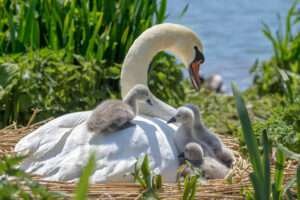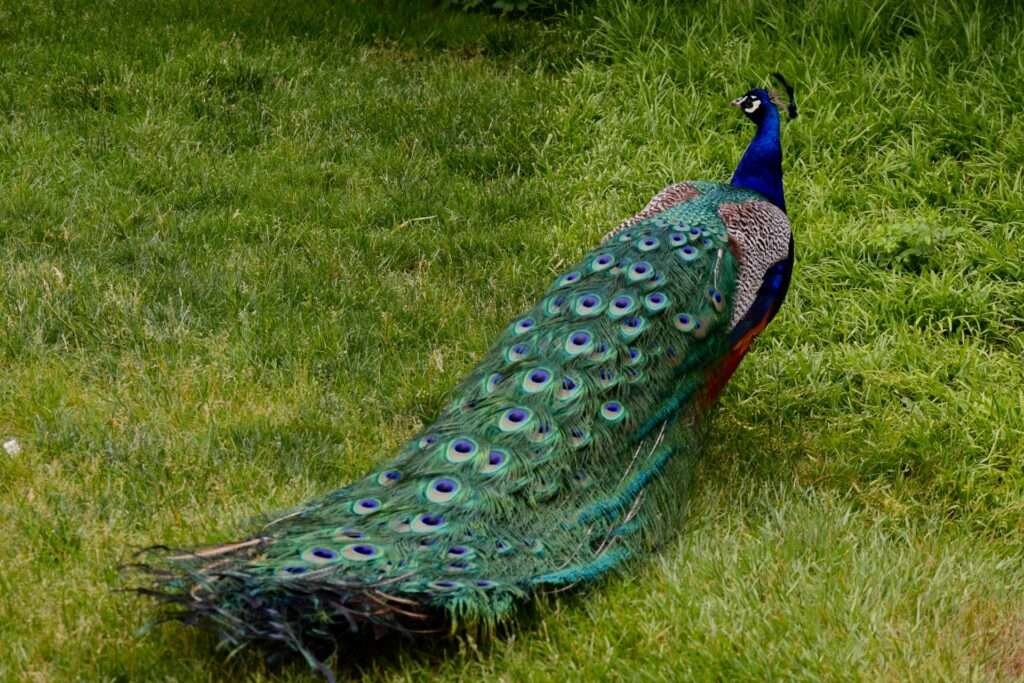We call a baby swan a cygnet. They feed on aquatic vegetation and small animals.
Swans are majestic birds known for the elegance and beauty in their adult plumage. However, when they first hatch, swans begin their journey in life as cygnets—small, fluffy baby birds that captivate with their innocence. These young are often characterized by their grey feathers, in contrast to the stark white of their mature counterparts.
Swan parents, known as pens (females) and cobs (males), are devoted caretakers. They nurture their brood, typically consisting of four to seven cygnets, in various environments, ranging from freshwater bodies to man-made waterways. Baby swans’ diet is diverse, combining aquatic plants with protein sources such as insects, tadpoles, and small fish—essential for their growth. Observing these creatures as they transform from cygnets into graceful birds, symbolizing love and fidelity, is a captivating experience for both bird enthusiasts and nature lovers.
Life Cycle of a Baby Swan
Hatching from the Nest
Hatching is the cygnet’s first challenge. Swans lay up to seven eggs, and the hatchlings emerge after about 30 days of incubation. Soft, downy white or grey feathers cover baby swans at birth.Feeding and growth
After hatching, cygnets quickly become voracious eaters. The diet of a baby swan includes insects, small fish, and plants. This helps them grow quickly, sometimes gaining up to a pound a week!- Diet: insects, fish, aquatic plants
- Growth: Up to 1 pound per week.
- Feathers range from downy to juvenile plumage.
Sibling Relationships
Cygnets often hatch with several siblings, forming a close bond. They stay together for safety and warmth, learning from their parents as well as from one another. The first months are crucial for developing social skills for their future as swans.| Age | Developmental Stage |
|---|---|
| Birth | Hatch the eggs and begin feeding. |
| 1-6 months | Rapid growth, forming sibling bonds |
| 6-12 months | Learning to fly, gaining independence |
The behaviour of a Baby Swan
Introduction The behaviour of a baby swan, also known as a cygnet, is fascinating and endearing. These young birds are born with a natural instinct for survival and a curiosity that propels them to interact with their environment. Let’s dive into the world of cygnets and explore how they grow under the watchful eyes of their parents. Nurturing by Parents
Nurturing by Parents
When cygnets hatch, their parents provide a nurturing environment critical for their development. Parent swans are highly protective and invest considerable time in caring for their young.
- Feeding: Cygnets receive their first meals from their parents, which consist mostly of insects, small fish, and plants.
- Warmth: They stay close to their mother, tucking under her wings for warmth, especially during cold nights.
- Swimming lessons: Within a few days, baby swans are led to water and learn to swim under the supervision of their parents.

Exploration of Surroundings
Curiosity defines the young swan’s journey. Water bodies serve as their perfect playground.
- Within weeks, cygnets start paddling, dabbling, and diving, discovering the aquatic world.
- They closely observe their parents and mimic their behaviour.
- Exploration expands to the land surrounding the water, where cygnets can be seen pecking at vegetation and small creatures.
Social Interactions
Social Interactions
Social development is vital for children. They form bonds with their family and learn to communicate through various sounds.
| Age | Interaction |
|---|---|
| Early Weeks | Follow your parents’ lead with little interaction with others. |
| One Month+ | Begin to interact with siblings, forming social bonds. |
| Three Months+ | Gain confidence and may join other Cygnets in ‘creches’ for short periods. |
Challenges Faced By Baby Swans
Predators and threats
Cygnets face danger from both land and water predators. Common enemies include:- Foxes
- Raccoons
- Large fish
- Birds of prey
Food Availability
Feeding a growing swan is no small feat. Cygnets eat a diet that includes:| Food Type | Source |
|---|---|
| Plants | Aquatic vegetation |
| Insects | Pond surfaces |
| Small Animals | Water and nearby land |
Environmental Factors
Cygnets’ survival is heavily influenced by environmental conditions. Key factors include:- Water quality
- Climate
- Habitat disruption
Frequently Asked Questions on Baby Swan
Swans turn white at what age?
Swans typically turn white at about one year of age as they mature into adults.
What Is A Swan Litter Called?
We refer to a group of baby swans as a brood or clutch.
How Do You Say, Baby Swan?
We call a baby swan a cygnet.
How Long Does It Take For A Cygnet To Become A Swan?
A cygnet typically becomes a swan within one year, reaching maturity with full white plumage.
Conclusion
Embracing the grace of baby swans, we find joy in their development from fluffy cygnets to majestic adults. These elegant creatures captivate us with their beauty and the promise of growth. As they journey from a soft grey to a pure white, we are reminded of nature’s transformative magic.




